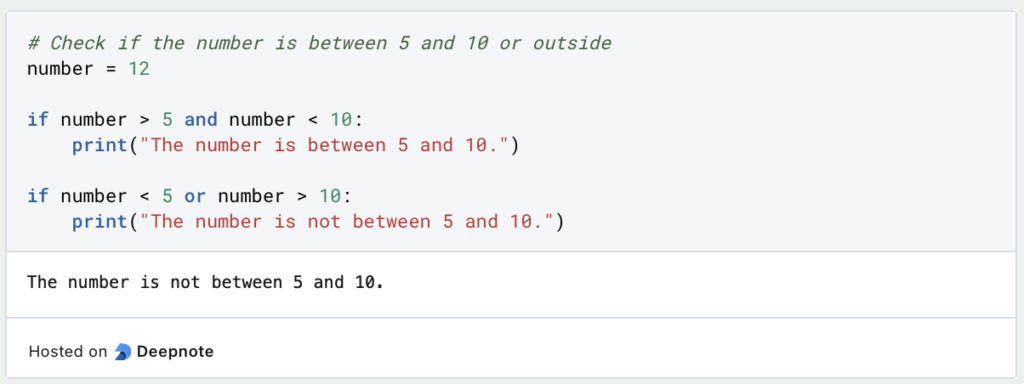In Python, there are various methods for building algorithms and mapping complex logic using conditional statements. One of the most basic building blocks is the Python if loop, which makes it possible to check “if-then conditions” and execute different blocks of code depending on the distinction. This article explains the basics of Python if loops and shows various examples of how they can be used in real life.
What is an if loop?
The if loop is a so-called control structure that is used in various programming languages to execute blocks of code based on conditions. It enables programmers to make decisions and adapt the code flow based on these decisions.
This functionality allows different paths to be provided in a program, which are run through dynamically based on input parameters. This enables the mapping of complex logic and a better user experience.
Compared to other control structures, the main difference with the Python if statement is that it is guided by conditions. Other control structures, such as loops, repeat code and stop when a certain condition is met. The if loop, on the other hand, does not determine the number of executions, but merely determines whether a code block is executed or not.
What is the syntax of the Python if loop?
The syntax of the Python if loop is relatively simple in its basic form, but can become significantly more complex in individual cases if nested conditions are involved. The basic syntax is as follows:

- If: The keyword “if” introduces the loop and indicates that a condition is defined below.
- Condition: The condition is checked and can return either true or false. If the condition is true, the following code block is executed. The final colon indicates the end of the condition.
- Indentation & code block: The colon is followed by an indentation that defines how long the code block is that is executed if the condition is true or skipped if the condition is false. Each indented line is part of this code block. The first line that is no longer indented is no longer part of the if loop and is executed in any case.
In a simple example, you can use a Python if loop to check whether a line is greater than five and output a message if this is the case. To do this, the condition that checks whether a number is greater than five is defined after the if statement:

The print statement is only executed if the specified number is actually greater than five, otherwise the block is skipped and the program has no output.
Which comparison operators can be used in a Python if loop?
The range of comparison operators that can be used in the if loop is large, making it a versatile tool for a wide variety of applications.
The following comparison operators can be used in an if loop:
- Equality („==“):

- Inequality („!=“):

- Greater („>“):

- Smaller („<“):

- Greater or equal („>=“):

- Smaller or equal („<=“):

Many conditions can already be checked with the help of these comparison operators. However, the customizability increases even further if several conditions are linked with so-called logical operators. For example, several partial conditions can be linked with an “and” or an “or”.
The following logical operators can be used:
- And operator (and): Returns True if both operands are True, False otherwise.
- Or operator (or): Returns True if at least one of the operands is True, False otherwise.
- Not operator (not): Negates the Boolean value, i.e. returns True if the operand is False, and vice versa.Hier sind ein paar Beispiele zur Nutzung dieser Operatoren:

The last logical operator is negation, which turns the truth of a statement into its opposite and is characterized in Python by the keyword “not”. A true condition therefore becomes a false statement with “not” and vice versa.

How are else and elif used?
In addition to the simple use of Python if loops, as we have seen so far, there are also other additions that enable extended control over the program flow.
With the help of “else”, a code block can be defined that is executed if the condition from the Python if loop is false. It is always used directly after the code block of the if loop without indentation. However, if the Python if loop is true, the code from the else block is simply skipped and the lines of code are executed next.

This simple addition makes it possible to intercept and handle the opposite case separately. However, the else block is not required when defining a Python if loop and only needs to be added if the opposite case is to be handled.
Another option is to use the so-called “elif” block. This is the abbreviation for “else if” and is used to check another condition if the first condition is false. The else block can also be used together with if and elif and is only executed if both the conditions from the if block and the condition from the elif block are false.

In itself, there is no limit to the possible elif blocks and it can therefore be used to query several conditions in succession. However, it is important to note that the order of definition plays an important role here, because as soon as the first condition is fulfilled, the subsequent blocks are no longer executed.

With the help of these additional blocks, various branches can be created within the if loops, allowing significantly more complex conditions to be executed. However, care must be taken when using them, as they can make a program unnecessarily complex, which in turn has a negative impact on performance.
What are nested if statements?
Nested if statements can also be used to create more complex algorithms. To do this, a new if loop is defined in the indentation of a first if loop. Using this technique, several conditions can be checked one after the other and different code blocks can be executed depending on this check.
The general syntax of a nested if statement is as follows:

In concrete terms, this can look like this:

In this code, the outermost statement is checked first, i.e. whether the number in the variable x is greater than five. If this condition is true, the print statement is executed and then the next if loops are run through, which in turn checks whether the variable y is greater than three.
In theory, an infinite number of nesting levels are possible. However, this makes the code more difficult to understand. In addition, many nesting levels can also be avoided by using logical operators.
What common errors occur when working with Python if loops?
Using the Python if loop is basically relatively simple, but can quickly become complex with the additional “elif” and “else” blocks. To ensure that the program runs smoothly, you should make sure that the following errors have not been made:
- Missing indentation: It must be ensured that the code block after the if condition is separated from the previous line by an indentation. Otherwise Python will not recognize the loop.
- Forgotten colons: The condition must always end with a colon. Otherwise Python throws a syntax error.
- Assignment instead of comparison operator: When using the comparison operator “==” to perform a comparison, care must be taken to ensure that two equals signs are used. Otherwise it is an assignment and a syntax error occurs again.
- Missing brackets for compound conditions: Although the use of round brackets to separate conditions is not a must, it can help to control the order of the conditions. You should therefore check whether brackets are set and which conditions they enclose.
- Logic errors: Particularly with complex loops, you should check the conditions in detail to ensure that they are formulated correctly and that the order matches. If several “elif” blocks are used, the sequence must also be checked to ensure that all conditions really make sense.
- Arrangement errors: The order in which conditions are tested should be checked very carefully. Often, supposed problems are caused by code being executed too early because a condition has already been fulfilled. It is therefore necessary to check whether the desired behavior is fulfilled by the conditional loop.
- Simplification of logic: Many nested conditions can be significantly simplified using comparison operators or logical operators. This not only avoids errors, but also makes the code much easier to understand.
If these points are taken into account, the risk of errors is already significantly reduced. However, these are only the most common sources of errors; there may of course be other reasons why the program cannot run.
This is what you should take with you
- Conditional statements are of crucial importance in various programming languages and especially in Python. They can be used to map complex algorithms.
- They can be used to create dynamic and interactive programs in which the flow of the code is actively controlled.
- It is important to understand the syntax, structure and different components of conditional statements in order to write clean and efficient code.
- To avoid errors, care should be taken to ensure consistent indentation and the addition of colons, among other things, to prevent the program from crashing.
- The Python if conditions can also be combined with logical operators such as the logical and and the logical or in order to check more complex conditions and also to avoid nested statements.
- With the help of elif, several conditions can be checked one after the other, which are executed if the previous condition is not met. However, the sequence must be observed here, as the program skips the loop as soon as the first condition is met.
What is Jenkins?
Mastering Jenkins: Streamline DevOps with Powerful Automation. Learn CI/CD Concepts & Boost Software Delivery.
What is XOR?
Explore XOR: The Exclusive OR operator's role in logic, encryption, math, AI, and technology.
How can you do Python Exception Handling?
Unlocking the Art of Python Exception Handling: Best Practices, Tips, and Key Differences Between Python 2 and Python 3.
What are Python Modules?
Explore Python modules: understand their role, enhance functionality, and streamline coding in diverse applications.
What are Python Comparison Operators?
Master Python comparison operators for precise logic and decision-making in programming.
What are Python Inputs and Outputs?
Master Python Inputs and Outputs: Explore inputs, outputs, and file handling in Python programming efficiently.
Other Articles on the Topic of Conditional Statements in Python
You can find a comprehensive overview of Python control flows here.

Niklas Lang
I have been working as a machine learning engineer and software developer since 2020 and am passionate about the world of data, algorithms and software development. In addition to my work in the field, I teach at several German universities, including the IU International University of Applied Sciences and the Baden-Württemberg Cooperative State University, in the fields of data science, mathematics and business analytics.
My goal is to present complex topics such as statistics and machine learning in a way that makes them not only understandable, but also exciting and tangible. I combine practical experience from industry with sound theoretical foundations to prepare my students in the best possible way for the challenges of the data world.





